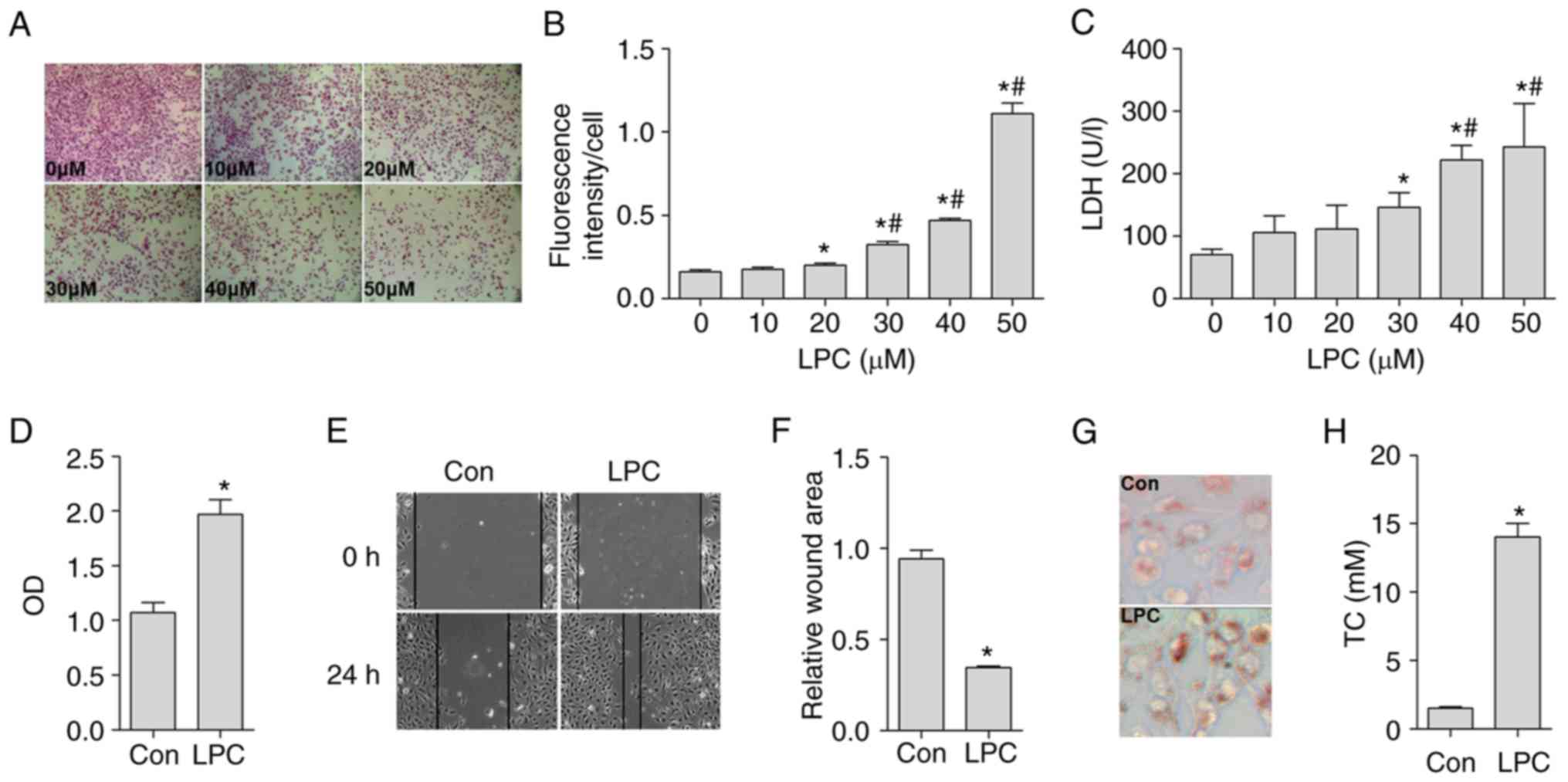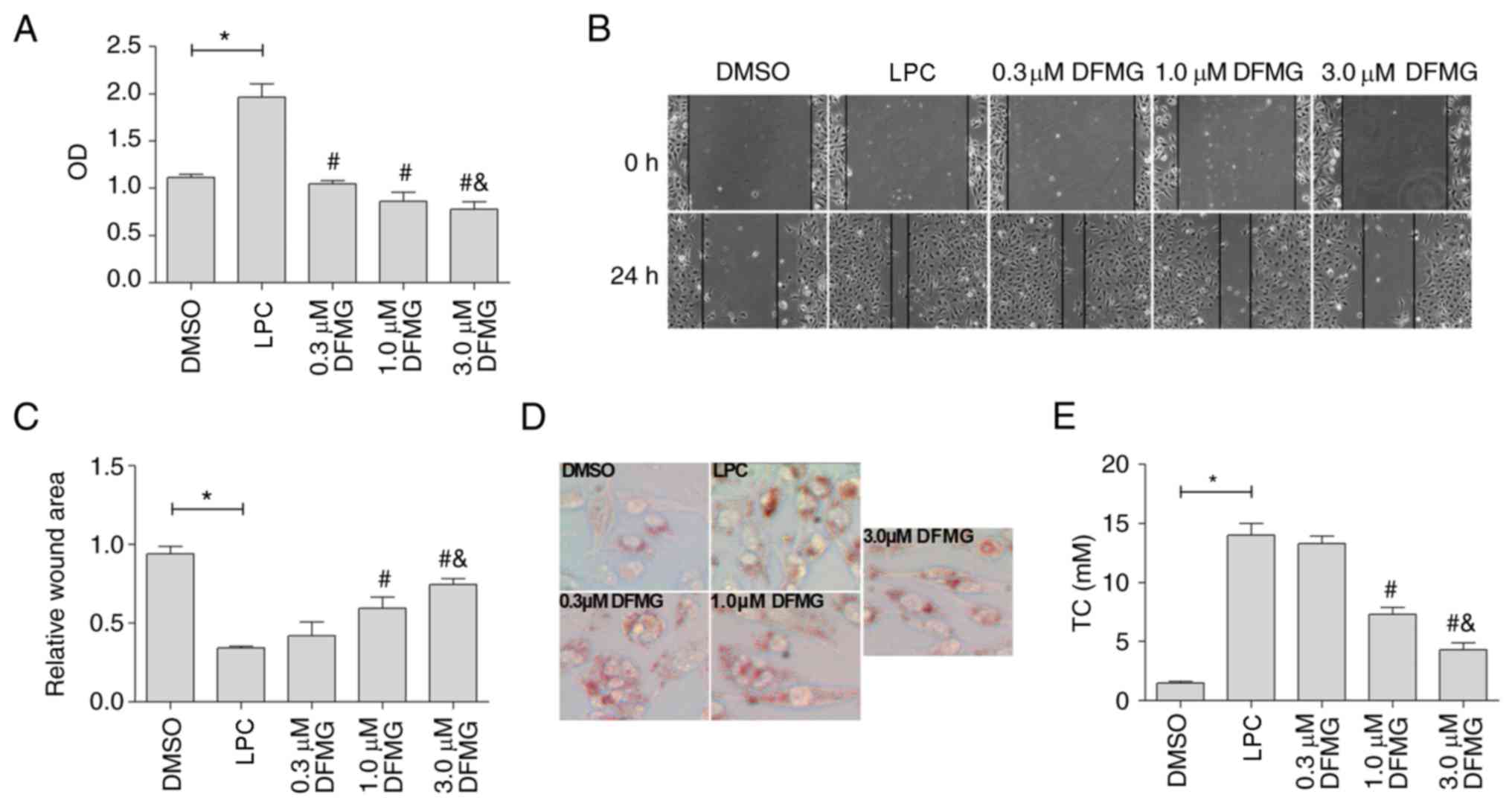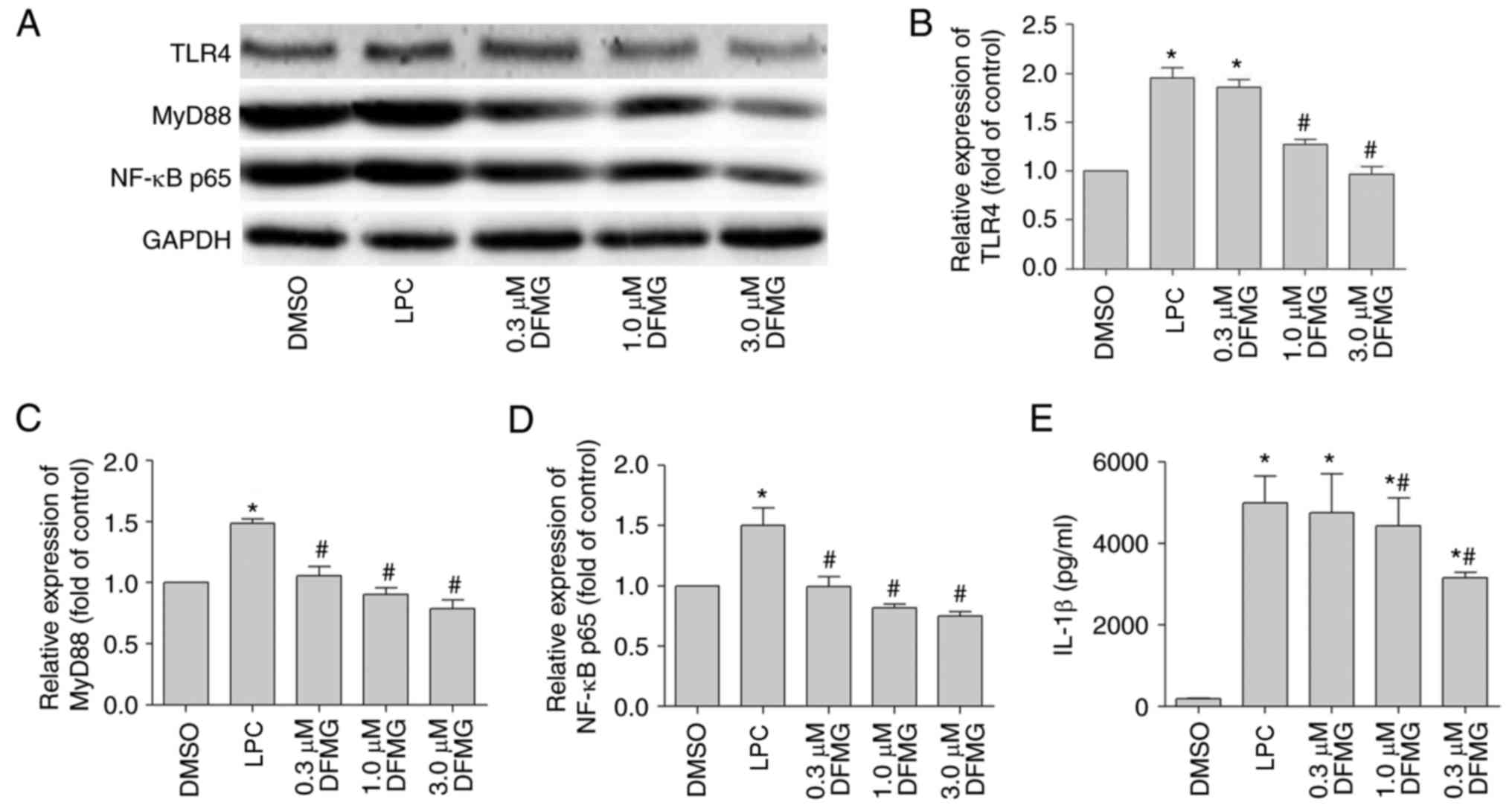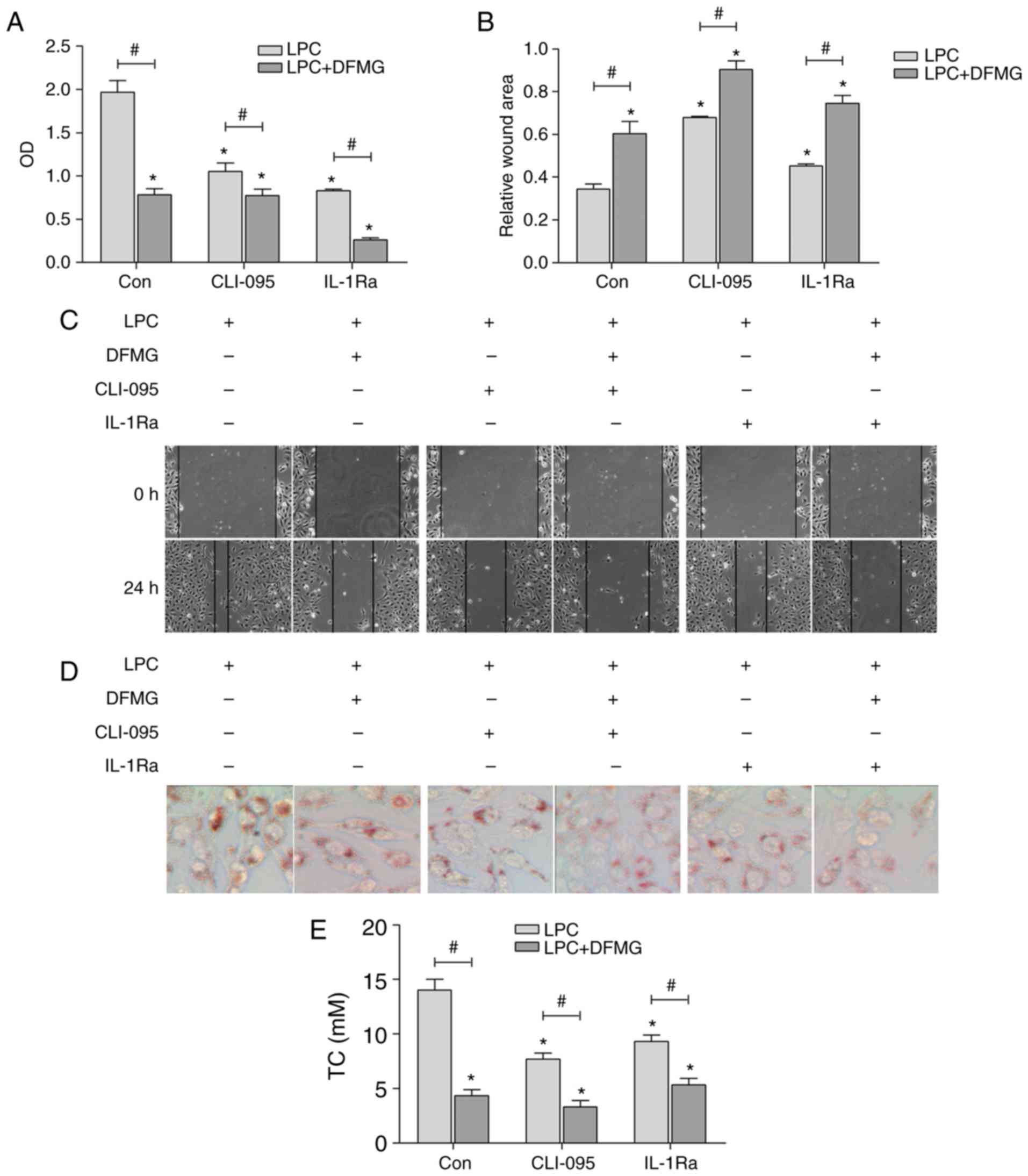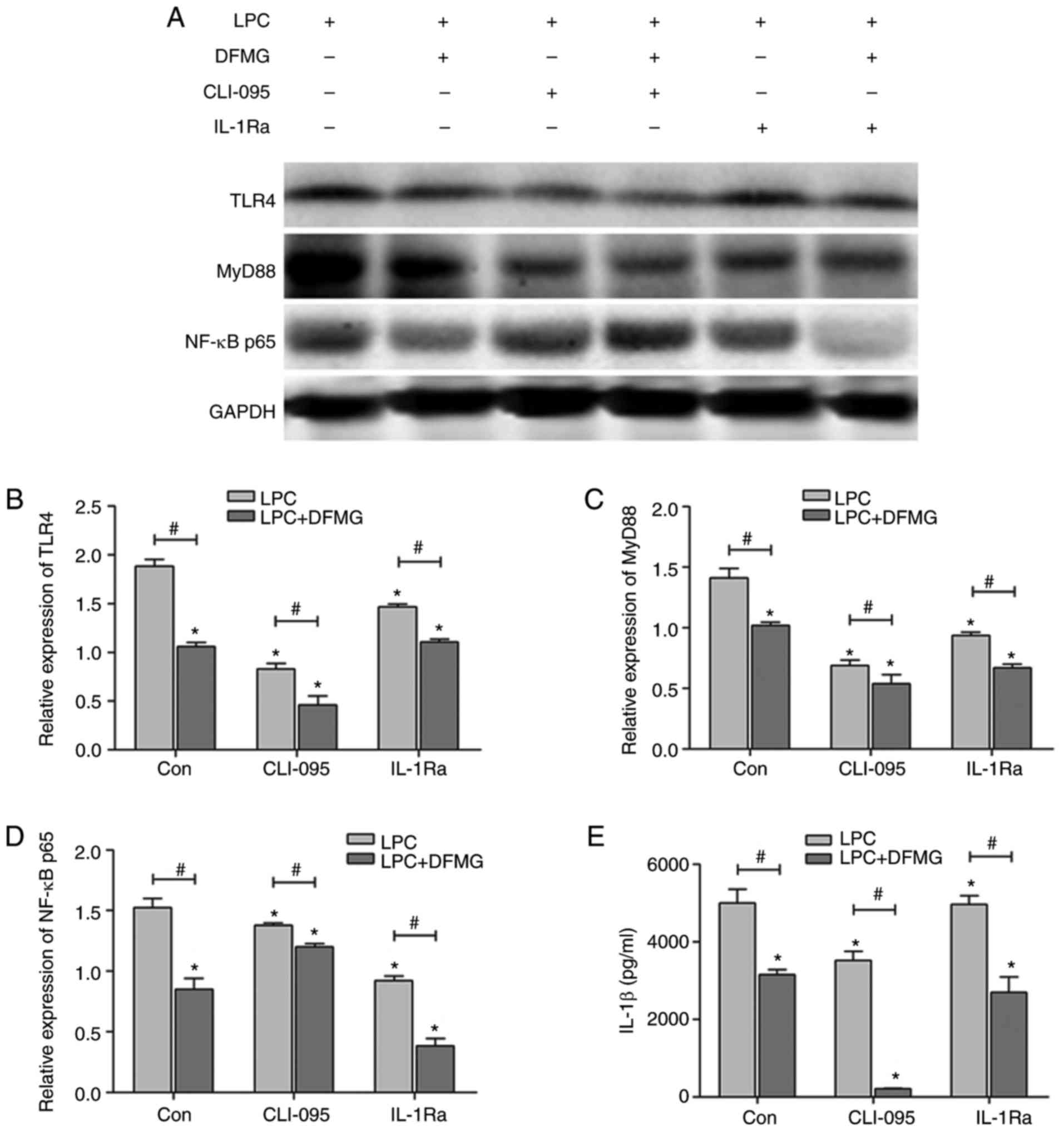|
1
|
Cochain C and Zernecke A: Macrophages in
vascular inflammation and atherosclerosis. Pflugers Arch.
469:485–499. 2017. View Article : Google Scholar : PubMed/NCBI
|
|
2
|
Gerrity RG, Naito HK, Richardson M and
Schwartz CJ: Dietary induced atherogenesis in swine. Morphology of
the intima in prelesion stages. Am J Pathol. 95:775–792.
1979.PubMed/NCBI
|
|
3
|
Galkina E and Ley K: Immune and
inflammatory mechanisms of atherosclerosis (*). Annu Rev Immunol.
27:165–197. 2009. View Article : Google Scholar
|
|
4
|
Weber C and Noels H: Atherosclerosis:
Current pathogenesis and therapeutic options. Nat Med.
17:1410–1422. 2011. View
Article : Google Scholar : PubMed/NCBI
|
|
5
|
Tabas I: Consequences and therapeutic
implications of macrophage apoptosis in atherosclerosis: The
importance of lesion stage and phagocytic efficiency. Arterioscler
Thromb Vasc Biol. 25:2255–2264. 2005. View Article : Google Scholar : PubMed/NCBI
|
|
6
|
Ilhan F and Kalkanli ST: Atherosclerosis
and the role of immune cells. World J Clin Cases. 3:345–352. 2015.
View Article : Google Scholar : PubMed/NCBI
|
|
7
|
Husain K, Hernandez W, Ansari RA and
Ferder L: Inflammation, oxidative stress and renin angiotensin
system in atherosclerosis. World J Biol Chem. 6:209–217. 2015.
View Article : Google Scholar : PubMed/NCBI
|
|
8
|
Gimbrone MA Jr and García-Cardeña G:
Endothelial cell dysfunction and the pathobiology of
atherosclerosis. Circ Res. 118:620–636. 2016. View Article : Google Scholar : PubMed/NCBI
|
|
9
|
Tabas I: Heart disease: Death-defying
plaque cells. Nature. 536:32–33. 2016. View Article : Google Scholar : PubMed/NCBI
|
|
10
|
Linton MF, Babaev VR, Huang J, Linton EF,
Tao H and Yancey PG: Macrophage apoptosis and efferocytosis in the
pathogenesis of atherosclerosis. Circ J. 80:2259–2268. 2016.
View Article : Google Scholar : PubMed/NCBI
|
|
11
|
Tabas I and Bornfeldt KE: Macrophage
phenotype and function in different stages of atherosclerosis. Circ
Res. 118:653–667. 2016. View Article : Google Scholar : PubMed/NCBI
|
|
12
|
Kalucka J, Bierhansl L, Wielockx B,
Carmeliet P and Eelen G: Interaction of endothelial cells with
macrophages-linking molecular and metabolic signaling. Pflugers
Arch. 469:473–483. 2017. View Article : Google Scholar : PubMed/NCBI
|
|
13
|
Pryshchep O, Ma-Krupa W, Younge BR,
Goronzy JJ and Weyand CM: Vessel-specific Toll-like receptor
profiles in human medium and large arteries. Circulation.
118:1276–1284. 2008. View Article : Google Scholar : PubMed/NCBI
|
|
14
|
Takeuchi O and Akira S: Pattern
recognition receptors and inflammation. Cell. 140:805–820. 2010.
View Article : Google Scholar : PubMed/NCBI
|
|
15
|
Ghosh G, Wang VY, Huang DB and Fusco A:
NF-κB regulation: Lessons from structures. Immunol Rev. 246:36–58.
2012. View Article : Google Scholar : PubMed/NCBI
|
|
16
|
Feng Y, Cai ZR, Tang Y, Hu G, Lu J, He D
and Wang S: TLR4/NF-κB signaling pathway-mediated and oxLDL-induced
up-regulation of LOX-1, MCP-1, and VCAM-1 expressions in human
umbilical vein endothelial cells. Genet Mol Res. 13:680–695. 2014.
View Article : Google Scholar : PubMed/NCBI
|
|
17
|
Zheng Z, Yuan R, Song M, Huo Y, Liu W, Cai
X, Zou H, Chen C and Ye J: The toll-like receptor 4-mediated
signaling pathway is activated following optic nerve injury in
mice. Brain Res. 1489:90–97. 2012. View Article : Google Scholar : PubMed/NCBI
|
|
18
|
Wang Z and Wu L: Melatonin alleviates
secondary brain damage and neurobehavioral dysfunction after
experimental subarachnoid hemorrhage: Possible involvement of
TLR4-mediated inflammatory pathway. J Pineal Res. 55:399–408.
2013.PubMed/NCBI
|
|
19
|
Palová-Jelínková L, Dáňová K, Drašarová H,
Dvořák M, Funda DP, Fundová P, Kotrbová-Kozak A, Černá M, Kamanová
J, Martin SF, et al: Pepsin digest of wheat gliadin fraction
increases production of IL-1β via TLR4/MyD88/TRIF/MAPK/NF-κB
signaling pathway and an NLRP3 inflammasome activation. PLoS One.
8:e624262013. View Article : Google Scholar
|
|
20
|
Nicoletti F, Patti F, DiMarco R, Zaccone
P, Nicoletti A, Meroni P and Reggio A: Circulating serum levels of
IL-1ra in patients with relapsing remitting multiple sclerosis are
normal during remission phases but significantly increased either
during exacerbations or in response to IFN-beta treatment.
Cytokine. 8:395–400. 1996. View Article : Google Scholar : PubMed/NCBI
|
|
21
|
Netea MG, Simon A, van de Veerdonk F,
Kullberg BJ, Van der Meer JW and Joosten LA: IL-1beta processing in
host defense: Beyond the inflammasomes. PLoS Pathog.
6:e10006612010. View Article : Google Scholar : PubMed/NCBI
|
|
22
|
Piccini A, Carta S, Tassi S, Lasiglié D,
Fossati G and Rubartelli A: ATP is released by monocytes stimulated
with pathogen-sensing receptor ligands and induces IL-1beta and
IL-18 secretion in an autocrine way. Proc Natl Acad Sci USA.
105:8067–8072. 2008. View Article : Google Scholar : PubMed/NCBI
|
|
23
|
Gu H, Jiao Y, Yu X, Li X, Wang W, Ding L
and Liu L: Resveratrol inhibits the IL-1β-induced expression of
MMP-13 and IL-6 in human articular chondrocytes via
TLR4/MyD88-dependent and -independent signaling cascades. Int J Mol
Med. 2017.Epub ahead of print. View Article : Google Scholar
|
|
24
|
Liu L, Gu H, Liu H, Jiao Y, Li K, Zhao Y,
An L and Yang J: Protective effect of resveratrol against
IL-1β-induced inflammatory response on human osteoarthritic
chondrocytes partly via the TLR4/MyD88/NF-κB signaling pathway: An
'in vitro study'. Int J Mol Sci. 15:6925–6940. 2014. View Article : Google Scholar : PubMed/NCBI
|
|
25
|
Feng Y, Cui Y, Gao JL, Li MH, Li R, Jiang
XH, Tian YX, Wang KJ, Cui CM and Cui JZ: Resveratrol attenuates
neuronal autophagy and inflammatory injury by inhibiting the
TLR4/NF-κB signaling pathway in experimental traumatic brain
injury. Int J Mol Med. 37:921–390. 2016. View Article : Google Scholar : PubMed/NCBI
|
|
26
|
Lee HH, Han MH, Hwang HJ, Kim GY, Moon SK,
Hyun JW, Kim WJ and Choi YH: Diallyl trisulfde exerts
anti-inflammatory effects in lipopolysaccharide-stimulated RAW
264.7 macrophages by suppressing the Toll-like receptor 4/nuclear
factor-κB pathway. Int J Mol Med. 35:487–495. 2015. View Article : Google Scholar
|
|
27
|
Zhu S, Tang S and Su F: Dioscin inhibits
ischemic stroke-induced inflammation through inhibition of the
TLR4/MyD88/NF-κB signaling pathway in a rat model. Mol Med Rep.
17:660–666. 2018.
|
|
28
|
Stojanovic I, Cuzzocrea S, Mangano K,
Mazzon E, Miljkovic D, Wang M, Donia M, Al Abed Y, Kim J, Nicoletti
F, et al: In vitro, ex vivo and in vivo immunopharmacological
activities of the isoxazoline compound VGX-1027: Modulation of
cytokine synthesis and prevention of both organ-specific and
systemic autoimmune diseases in murine models. Clin Immunol.
123:311–323. 2007. View Article : Google Scholar : PubMed/NCBI
|
|
29
|
Fagone P, Muthumani K, Mangano K, Magro G,
Meroni PL, Kim JJ, Sardesai NY, Weiner DB and Nicoletti F: VGX-1027
modulates genes involved in the lipopolysaccharide-induced
toll-like receptor 4 activation and in a murine model of systemic
lupus erythematosus. Immunology. 142:594–602. 2014. View Article : Google Scholar : PubMed/NCBI
|
|
30
|
Pangeni R, Sahni JK, Ali J, Sharma S and
Baboota S: Resveratrol: Review on therapeutic potential and recent
advances in drug delivery. Expert Opin Drug Deliv. 11:1285–1298.
2014. View Article : Google Scholar : PubMed/NCBI
|
|
31
|
Fu XH, Wang L, Zhao H, Xiang HL and Cao
JG: Synthesis of genistein derivatives and determination of their
protective effects against vascular endothelial cell damages caused
by hydrogen peroxide. Bioorg Med Chem Lett. 18:513–517. 2008.
View Article : Google Scholar
|
|
32
|
Zhao H, Li C, Cao JG, Xiang HL, Yang HZ,
You JL, Li CL and Fu XH: 7-Difluoromethyl-5,4′-dimethoxygenistein,
a novel genistein derivative, has therapeutic effects on
atherosclerosis in a rabbit model. J Cardiovasc Pharmacol.
54:412–420. 2009. View Article : Google Scholar : PubMed/NCBI
|
|
33
|
Wang L, Zheng X, Xiang HL, Fu XH and Cao
JG: 7-Difluoromethyl-5,4′-dimethoxygenistein inhibits oxidative
stress induced adhesion between endothelial cells and monocytes via
NF-kappaB. Eur J Pharmacol. 605:31–35. 2009. View Article : Google Scholar : PubMed/NCBI
|
|
34
|
Liu S, Li L, Zhang J, Huang H, Yang S, Ren
C, Fu X and Zhang Y: 7-Difluoromethyl-5, 4′-dimethoxygenistein
reverses LPC-induced apoptosis of HUVE-12 cells through regulating
mitochondrial apoptosis pathway. Curr Signal Transd T. 9:50–58.
2014. View Article : Google Scholar
|
|
35
|
Liu F, Cao JG, Li C, Tan JS and Fu XH:
Protective effects of 7-difluoromethyl-5,4′-dimethoxygenistein
against human aorta endothelial injury caused by lysophosphatidyl
choline. Mol Cell Biochem. 363:147–155. 2012. View Article : Google Scholar
|
|
36
|
Kong F, Ye B, Cao J, Cai X, Lin L, Huang
S, Huang W and Huang Z: Curcumin represses NLRP3 inflammasome
activation via TLR4/MyD88/NF-κB and P2X7R signaling in PMA-induced
macrophages. Front Pharmacol. 7:3692016. View Article : Google Scholar
|
|
37
|
Eaton KV, Yang HL, Giachelli CM and
Scatena M: Engineering macrophages to control the inflammatory
response and angiogenesis. Exp Cell Res. 339:300–309. 2015.
View Article : Google Scholar : PubMed/NCBI
|
|
38
|
Im GI: Coculture in musculoskeletal tissue
regeneration. Tissue Eng Part B Rev. 20:545–554. 2014. View Article : Google Scholar : PubMed/NCBI
|
|
39
|
Wang L, Huang Z, Huang W, Chen X, Shan P,
Zhong P, Khan Z, Wang J, Fang Q, Liang G and Wang Y: Inhibition of
epidermal growth factor receptor attenuates atherosclerosis via
decreasing inflammation and oxidative stress. Sci Rep. 8:459172017.
View Article : Google Scholar : PubMed/NCBI
|
|
40
|
Voight BF, Peloso GM, Orho-Melander M,
Frikke-Schmidt R, Barbalic M, Jensen MK, Hindy G, Hólm H, Ding EL,
Johnson T, et al: Plasma HDL cholesterol and risk of myocardial
infarction: A mendelian randomisation study. Lancet. 380:572–580.
2012. View Article : Google Scholar : PubMed/NCBI
|
|
41
|
Canfrán-Duque A, Rotllan N, Zhang X,
Fernández-Fuertes M, Ramírez-Hidalgo C, Araldi E, Daimiel L, Busto
R, Fernández-Hernando C and Suárez Y: Macrophage deficiency of
miR-21 promotes apoptosis, plaque necrosis, and vascular
inflammation during atherogenesis. EMBO Mol Med. 9:1244–1262. 2017.
View Article : Google Scholar : PubMed/NCBI
|
|
42
|
Szatmary Z: Molecular biology of toll-like
receptors. Gen Physiol Biophys. 31:357–366. 2012. View Article : Google Scholar : PubMed/NCBI
|
|
43
|
Ii M, Matsunaga N, Hazeki K, Nakamura K,
Takashima K, Seya T, Hazeki O, Kitazaki T and Iizawa Y: A novel
cyclohexene derivative, ethyl
(6R)-6-[N-(2-Chloro-4-fluorophenyl)sulfamoyl]
cyclohex-1-ene-1-carboxylate (TAK-242), selectively inhibits
toll-like receptor 4-mediated cytokine production through
suppression of intracellular signaling. Mol Pharmacol.
69:1288–1295. 2006. View Article : Google Scholar
|
|
44
|
Kawamoto T, Ii M, Kitazaki T, Iizawa Y and
Kimura H: TAK-242 selectively suppresses Toll-like receptor
4-signaling mediated by the intracellular domain. Eur J Pharmacol.
584:40–48. 2008. View Article : Google Scholar : PubMed/NCBI
|
|
45
|
D ujmovic I, Mangano K, Pekmezovic T,
Quattrocchi C, Mesaros S, Stojsavljevic N, Nicoletti F and Drulovic
J: The analysis of IL-1 beta and its naturally occurring inhibitors
in multiple sclerosis: The elevation of IL-1 receptor antagonist
and IL-1 receptor type II after steroid therapy. J Neuroimmunol.
207:101–106. 2009. View Article : Google Scholar
|
|
46
|
van Oosten BW, Lai M, Hodgkinson S,
Barkhof F, Miller DH, Moseley IF, Thompson AJ, Rudge P, McDougall
A, McLeod JG, et al: Treatment of multiple sclerosis with the
monoclonal anti-CD4 antibody cM-T412: Results of a randomized,
double-blind, placebo-controlled, MR-monitored phase II trial.
Neurology. 49:351–357. 1997. View Article : Google Scholar : PubMed/NCBI
|
|
47
|
Yoon GS, Sud S, Keswani RK, Baik J,
Standiford TJ, Stringer KA and Rosania GR: Phagocytosed Clofazimine
Biocrystals can modulate innate immune signaling by inhibiting TNFα
and boosting IL-1RA secretion. Mol Pharm. 12:2517–2527. 2015.
View Article : Google Scholar : PubMed/NCBI
|
|
48
|
Jeong JW, Lee HH, Han MH, Kim GY, Kim WJ
and Choi YH: Anti-inflammatory effects of genistein via suppression
of the toll-like receptor 4-mediated signaling pathway in
lipopoly-saccharide-stimulated BV2 microglia. Chem Biol Interact.
212:30–39. 2014. View Article : Google Scholar : PubMed/NCBI
Zhou X, Yuan L, Zhao X, Hou C, Ma W, Yu H
and Xiao R: Genistein antagonizes inflammatory damage induced by
β-amyloid peptide in microglia through TLR4 and NF-κB. Nutrition.
30:90–95. 2014. View Article : Google Scholar
|
|
49
|
Ma W, Ding B, Yu H, Yuan L, Xi Y and Xiao
R: Genistein alleviates β-amyloid-induced inflammatory damage
through regulating Toll-like receptor 4/nuclear factor κB. J Med
Food. 18:273–279. 2015. View Article : Google Scholar :
|
|
50
|
Cave NJ, Backus RC, Marks SL and Klasing
KC: The bioavailability and disposition kinetics of genistein in
cats. J Vet Pharmacol Ther. 30:327–335. 2007. View Article : Google Scholar : PubMed/NCBI
|
|
51
|
Petrasek J, Dolganiuc A, Csak T,
Kurt-Jones EA and Szabo G: Type I interferons protect from
Toll-like receptor 9-associated liver injury and regulate IL-1
receptor antagonist in mice. Gastroenterology. 140:697–708.e4.
2011. View Article : Google Scholar :
|
|
52
|
Rogier R, Ederveen THA, Boekhorst J,
Wopereis H, Scher JU, Manasson J, Frambach SJCM, Knol J, Garssen J,
van der Kraan PM, et al: Aberrant intestinal microbiota due to IL-1
receptor antagonist deficiency promotes IL-17 and TLR4-dependent
arthritis. Microbiome. 5:632017. View Article : Google Scholar
|
|
53
|
Li D, Jin Y, Sun Y, Lei J and Liu C:
Knockdown of toll-like receptor 4 inhibits human NSCLC cancer cell
growth and inflammatory cytokine secretion in vitro and in vivo.
Int J Oncol. 45:813–821. 2014. View Article : Google Scholar : PubMed/NCBI
|
|
54
|
Samara KD, Antoniou KM, Karagiannis K,
Margaritopoulos G, Lasithiotaki I, Koutala E and Siafakas NM:
Expression profiles of Toll-like receptors in non-small cell lung
cancer and idiopathic pulmonary fbrosis. Int J Oncol. 40:1397–1404.
2012.PubMed/NCBI
|
|
55
|
Yang Y, Lv J, Jiang S, Ma Z, Wang D, Hu W,
Deng C, Fan C, Di S, Sun Y and Yi W: The emerging role of Toll-like
receptor 4 in myocardial inflammation. Cell Death Dis. 7:e22342016.
View Article : Google Scholar : PubMed/NCBI
|
|
56
|
Cha JJ, Hyun YY, Lee MH, Kim JE, Nam DH,
Song HK, Kang YS, Lee JE, Kim HW, Han JY and Cha DR: Renal
protective effects of toll-like receptor 4 signaling blockade in
type 2 diabetic mice. Endocrinology. 154:2144–2155. 2013.
View Article : Google Scholar : PubMed/NCBI
|















